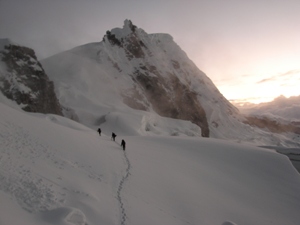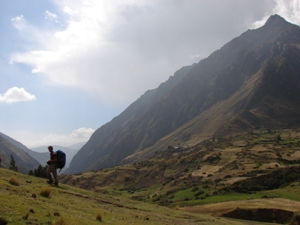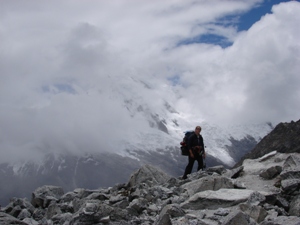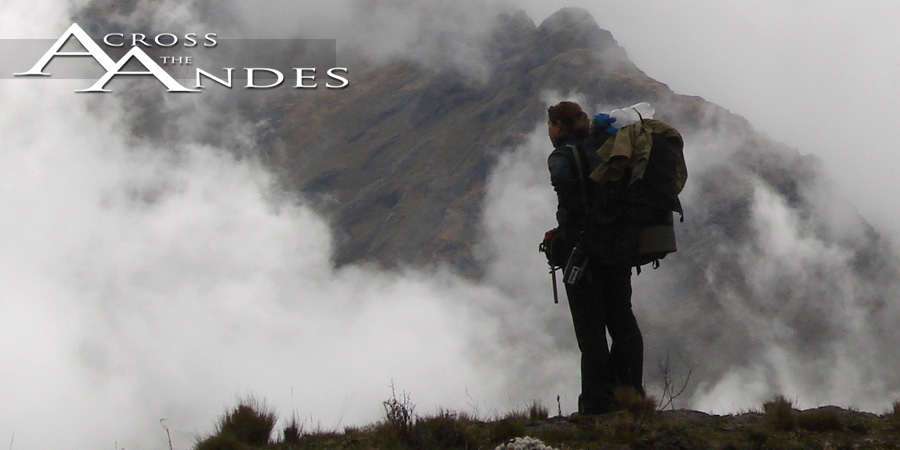Blanca Bliss
By Deia Schlosberg
November 23, 2006

Good section. We began on November 3rd (those of you with photos
for me, don’t worry about sending them quickly, but I still want them
when you get a chance) hiking an Incan Road out of Leimebamba. We found
ourselves in a very different environment than from where we left off
on the other side of the Rio Marañon in Calemar. We were now in the
midst of some serious limestone folding with huge slabs of gray stone
rising up on both sides of us. For several days we followed a fairly
straightforward trail/cowpath/Incan road south through this high
valley, but of course not without its share of dropping and climbing,
being the Andes and all. The whole time meeting more lovely campo
people and being amazed at the power of seismic activity as we looked
across giant valleys to see mile-thick sections of earth clearly folded
in half. Also during this portion, our anticipation was silently
building due to the fact that our topo maps showed that in not so many
kilometers, we would be crossing contour lines of blue rather than
brown and green. The glaciers that give the Blanca its name were
getting closer; we were approaching the big guys. This was obvious with
a quick glance around as well, but the maps gave us a little additional
perspective. Somewhere along the way, below Lake Pelegatos, I was
attacked by a dog, apparently freaked out by two huge gringos with
packs, which it had never seen. The people of the town were
exceptionally nice, helping me clean out the bite, and then giving me a
clump of hair from the guilty dog to put on it (I graciously declined
this second offer). Now thinking back, I am appreciative that
litigation never entered the picture, whereas if this happened in the
States, the owner (if there actually was one) would immediately be
fearful of being sued and having its dog taken away and perhaps put
down. We just made sure the dog was healthy, enjoyed our gift of lake
trout for our troubles, and continued on our way, up several thousand
feet to the pampa above. I don’t have rabies.

We stopped for a day in Conchucos to resupply and do some needed washing. It’s much harder to stay clean for a long time when it rains every day and nothing has a chance to dry out. From Conchucos, we climbed an Incan road out of town up into the very high country. The peaks got even more jagged and the slopes even more steep as we crossed into Ancash, region of National Geographic specials and our home for the time being. Every turn around a bend, as if it didn’t before, brought amazement and a need to comment to verify its reality with one another. The pictures are great, but they can’t even begin to capture the immensity of space the Earth plays with here. Our last night in the field on the trek portion of this chapter was spent hiking even further up to a pass at 14,400 ft. We were pretty sure we would be able to get a good view of the nevados (snow-capped peaks) from here, but upon reaching the top, we were met with a wall of cloud on the opposite side of the valley. We made camp high as the sun set, hoping for a morning view of the ridge we knew must be across the way. We were not disappointed. We unzipped the rainfly in the early morning to see a crystal-clear dew-covered day, and sure enough, white-capped, 20,000 ft. peaks on the other side of the valley greeted the morning sun as well. Lots of miles and lots of living got us to the heart of the Andes, and there they were looking back at us, waiting. Alpamayo and the gang. We had planned our route down to Tarica, a very small town in the valley, and then southwest, skirting the bottoms of the monoliths, before heading south along their eastern slopes. However, with our good friends Dave and Jessie planning to meet us in a couple of days, we decided to save that trek and hop on the only bus that day from Tarica to Huaraz, which was leaving the minute we arrived in town. I hate to say it, but the bus ride was perhaps one of the greatest thrills of the trip so far. The amazingly constructed national park roads in some of the U.S. parks have nothing on the run of the mill average Andean road. We were wowed with unbelievable views for 7 hours straight as we passed through high mountains, 10,000 ft. deep canyons, environments that ranged from red rock, cactus-covered desert, to palm-filled green river valleys, and a series of tunnels that seemed out of a dream. Once in Huaraz, a small and lovely city surrounded by nevados, we met some new friends that have us feeling like Huaraz is our home away from home. We awaited anxiously for Dave and Jessie to show up, and after a wonderful reunion and a bit of celebration, we headed back to the mountains, though this time, to climb up one instead of just walking around it. Mt. Pisco is still not real to me. We found ourselves a guide and some gear—crampons, ice axes, ropes and the like—-and took off crammed in a cab for the national park (Huascaron). Arriving late at night, we set up camp in Cebolla Pampa, hoping that the rain would mellow out for the next few days. This was our one chance to do a summit, and if the weather decided it wasn’t meant to be, there was no arguing. If it’s storming up high, it’s just not a good idea to go up and we would have had to turn back. The next morning, however, we awoke to pink light on the white mountains around us and packed up our wet gear to hike up to Moraine Camp. Several hours up switchbacks brought us to the refugio, which used to be the starting point for the actual climb of Pisco, but the glacier has since receded, leaving the refugio two hours shy of an optimal starting point. We continued, picking our way across giant boulders that are the moraine field, up and down slopes created by moving ice sheets. Cresting the final ridge we could see a beautiful glacial blue lake (made so from the silt and how light plays off of it) as well as our campsite at the base of the glacier. From midday here, at 16,000 ft. we tried to rest and eat and prepare for our 2 a.m. departure for the summit. All of us were feeling the effects of the altitude, somewhat like a bad hangover, making it difficult to sleep or eat, the two most important things to do in preparation. Two o’clock came quickly. We bundled up, geared up, put our packs on, and took off. I worried that my headache would continue to worsen the higher up we got, and that my fingers and their horrible circulation would again cause us to turn back early. However, once we got going, it was clear that Pisco was much more forgiving, at least on this night, than Cotopaxi. No wind, few clouds above us, and mild temperatures for above 16,000 ft. And although our elevation was impossible to forget, it was possible to work through.

The climb alternated between sections of steep snow-walking and more gradual portions. Making our way by headlamp, all we could see was the area of snow in front of us and our friends’ lights, spaced out in 10 meter intervals along the rope. The sounds were the crunching of crampons on the glacier and heavy breathing. Perhaps the most magical hour of my life came next. Sunrise from the glacier, with a blanketing of cloud below us, and our view was the peaks rising above the clouds all around us. All above 19,000 ft., some over 22,000 ft., all cast in pink with the gray early-morning light reflecting off the glacier around us. All very surreal, all fitting to a T the definition of beauty as far as I’m concerned. Now we were able to see what we were walking amongst. Crevasses on both sides of us revealed hundreds of layers of ice-pack here, and twisted edges of ice walls draped with icicles seemed to emit their own blue light. The climb seemed to last for days. The peak looked far off until the very end. Until our guide, Ronald, told us that we had two minutes to go to the summit (by this time we were in a white out of snow flurries), I didn’t let myself believe that we had made it. It was mid-morning and we were standing at almost 19,000 ft. The most challenging single feat I have ever done was at its climax, and I was getting to share it with three of my closest friends in this world. We laughed in disbelief and some tears were shed as it sunk in. Ronald shared his apple with us all, and after some pictures were taken, we began the descent. There seemed to be a delay in our feeling the affects of the reduced oxygen, so by the time we started down, we were all ready to be way down, and quickly. There’s also a strange physiological phenomenon that occurs when coming down from high elevations. The body has been working overtime to push red blood cells through the system to cart the few available oxygen molecules around, but as it descends and there is more oxygen, it keeps working in overdrive for a little while, and so there is a spike in red blood cell activity due to overcompensation. This makes one ridiculously hot very quickly. So that at 19,000 ft., walking through snow, with snow falling, we were all extremely hot in our single base layer, and with the nausea of the altitude, it wasn’t a pleasant feeling. Though a few hours of discomfort was a very small price to pay for getting to see and experience a part of this planet that few know. I am one lucky human. In order to get back to Huaraz in time for a Thanksgiving celebration with the other Americans here, we had to hike the whole way out after descending from the peak. We were not the most lucid at this point, having already put our bodies through what we did on very little sleep and food and oxygen. But the memories of those sensations fade, and the memories of my expanded perception of what exists in the world does not. Needless to say, we rested up through all of the a.m. hours, and made it to a lovely Thanksgiving dinner just in time. Although we weren’t able to be with our families, we were with loved ones and were certainly made to feel at home. Thanks to all of our friends in Huaraz for everything they’ve done for us. From here, we resume the walking where we left off, but this time as a quad instead of a pair. Until next time … signing off from the Blanca.







